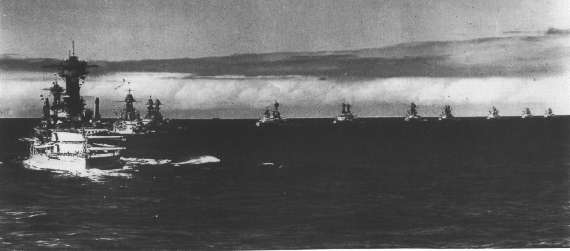
The true beginning of the modern battleship was the availability and the usability of steel in large quantities. The first iron warships, build in France, Britian and the United States, were almost invulnerable. Their success, and the fact that they were able to sink any wooden warship with ease, resulted in the rapid diminishing of wooden warships as the main fighting tool.
It was not until 1905, however, that the true form of the battleship was seen on the seas. The British Dreadnought was so radically advanced that it became the namesake for all future battleships. Its main features were its high speed for the time, a full 5 knots above contemporary ships of the line, and it's main armament, consisting only of high caliber guns. Before it, the so-called ships of the line carried, normally, four high-caliber, ten medium-caliber and around twenty low-caliber guns. Now the Dreadnought sailed, bringing ten high-caliber guns to bear. Her appearance, much like that of the steel warships, had made all earlier battleship designs obsolete.
Dreadnought, however, only received the honor of being the first because the USS Michigan class was by far better designed when it appeared in 1910, showing the best favorable fitting of heavy guns possible: four turrets, two each fore and aft, one on each end superfiring the other. This advanced design is probably more properly termed the "father of all battleships".
The design of Dreadnought had, as mentioned, made all former BB's (BB is the US designation of battleships) obsolete. Thus, all major navies began construction programs. In the case of the United States, after several ships that were of a pretty common design, meaning equal ships could be found in most European navies. These classes included the Delaware, Florida, Wyoming, and Texas classes, a total of eight ships.
Real innovation began with the Nevada and Pennsylvania classes of 1916. Mounting ten respectively twelve guns in two triple and two double respectively four triple turrets, they were ships without equal in the world, except perhaps the British Queen Elizabeth and Italian Conte di Cavour. They had their guns mounted exclusively fore and aft, without a central turret, in superfiring positions.
The next class was New Mexico, carrying the same armament as the Pennsylvanias. The next step forward was the Maryland class, which followed the Tennesses, which had again copied the succesful Pennsylvania class. Maryland, again basically a Pennsylvania, traded the 356mm guns against 406mm guns. Commisioned first in 1921, Maryland was build to match the Japanese Nagato class. The Marylands were the last battleships the United States build for a long time. The reason for this was the Washington Treaty of 1921, which restricted the tonnage of total battleships a nation was allowed to possess (forcing Great Britian to scrap several of it's ships) and disallowed construction of battleships at all.
Finally, in 1936, after the London Treaty, two battleships of 35000 tons were ordered into production, the North Carolina class. The two ships, North Carolina and Washington were some of the best battleships available to any navy at the time of their commision, April and May 1941 respectively. Going up to 28 knots, they would become two of the Navy's ten fast battleships. Washington would in 1942 sink the Japanese battleship Kirishima.
Following this class was the South Dakota class, of the same tonnage as the North Carolinas, but was of a smaller length, allowing for the reduced weight be used for extended armor. South Dakota became the first fast battleship adequately armored against 16" fire.
Last but not least of the battleships was the magnificent Iowa class, the best of all battleships ever build (Conclusion drawn from Jon Parshall's Battleship comparison page, see on-page link, in the toolbar on the left.). This class had the same armament as the earlier fast battleships, nine 406mm guns, but of a newer and better model, and was able to go up to 33 (!) knots.
These
ships saw extensive servie during World War 2, and continued, with breaks,
to serve the United States until 1991, when USS Missouri and Wisconsin
fired on Iraqi troops and installations during Operation Desert Storm.
For more
extensive data and service records (well, sorta) see the respective ship
classes, on the left.
by Keith E. Allen
Battleships
BB-61
Iowa class
BB-57
South Dakota class
BB-55
North Carolina class
BB-46
Maryland class
BB-43
Tennessee class
BB-40
New Mexico class
BB-38
Pennsylvania class
BB-36
Nevada class
BB-35
New York class
BB-32
Wyoming class